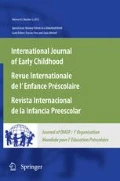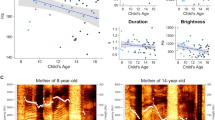Abstract
Voice is a basic tool in communication between adults. However, in early educational settings, adult professionals use their voices in different paralinguistic ways when they communicate with children. A teacher’s use of voice is important because it serves to communicate attitudes and emotions in ways that are often ignored in early childhood classroom research. When teachers take different roles in relation to children, they use their voice with different pitch, melody, and loudness. This research examined how various acoustic elements in teachers’ voices are associated with different teaching roles when explored from a child-sensitive perspective. The paper proposes an analytical framework in order to characterize paralinguistic elements in teacher’s voices with potential consequences for children’s affective responses. The paper analyzes auditory elements (pitch, melody, and loudness) that can be recognized in the voices of adult professionals. These are categorized with reference to four different teacher roles: a mentor role, a nurturer role, a controller role, and a playmate role. The findings reveal how auditory elements of teachers’ voices need consideration when planning and evaluating educational practice.
Résumé
La voix est un outil de base dans la communication entre adultes. Cependant, dans les milieux d’éducation des jeunes enfants, les professionnels adultes utilisent leurs voix de différentes façons paralinguistiques lorsqu’ils communiquent avec les enfants. L’utilisation de la voix par l’enseignant est importante parce qu’elle sert à communiquer des attitudes et des émotions de manières souvent ignorées dans la recherche sur la salle de classe préscolaire. Lorsque les enseignants prennent différents rôles en relation avec les enfants, ils utilisent leur voix avec un ton, une mélodie et une force différents. Cette recherche a examiné comment divers éléments acoustiques des voix des enseignants sont associés à différents rôles de l’enseignant lorsqu’ils sont examinés d’un point de vue sensible à l’enfant. L’article propose un cadre d’analyse afin de caractériser les éléments paralinguistiques des voix des enseignants avec des conséquences potentielles sur les réactions affectives des enfants. L’article analyse les éléments auditifs (ton, mélodie et force) qui peuvent être reconnus dans la voix des professionnels adultes. Ceux-ci sont classés en fonction de quatre différents rôles de l’enseignant: un rôle de mentor, un rôle de soignant, un rôle de contrôleur et un rôle de compagnon de jeu. Les résultats révèlent comment les éléments sonores des voix des enseignants doivent être pris en compte dans la planification et l’évaluation de la pratique éducative.
Resumen
La voz es una herramienta básica en la comunicación entre adultos. Sin embargo, en ambientes de educación temprana, los profesionales adultos usan sus voces en diversas formas paralingüísticas cuando se comunican con los niños. El uso de la voz de un maestro es importante ya que sirve para comunicar actitudes y emociones de formas que son habitualmente ignoradas en los salones de clases. Cuando los profesores toman diferentes roles en relación a los niños, utilizan su voz con diferentes tonos, melodía y fuerza. Esta investigación examinó cómo una variedad de elementos acústicos de las voces de los maestros se asocian con diferentes roles de enseñanza al ser exploradas desde la perspectiva de la sensibilidad del niño. El paper propone un marco analítico para caracterizar elementos paralingüísticos en las voces de los maestros con consecuencias potenciales para la respuesta afectiva de los niños. El paper analiza elementos auditivos (tono, melodía y fuerza) que pueden ser reconocidos en las voces de profesionales adultos. Estos son categorizados con referencia a cuatro roles diferentes de los profesores: el rol de mentor, el de educador, el de controlador y el de compañero de juegos. Los resultados revelaron cómo los elementos audibles de las voces de los profesores necesitan consideración al momento de planificar y evaluar la práctica educacional.

Similar content being viewed by others
Notes
Pitch is a perceptual property of sounds that allows their ordering on a frequency-scale that allows us to classify a sound as relatively high or low (Liberman 2013).
Melody or pitch-range is the degree of variation from the average pitch of the voice, also referred to as ‘the melody of speech,’ ‘intonation’ or ‘tone of voice’ (Kreiman and Sidtis 2011).
Loudness is defined as ‘the sensation magnitude of sound’ related to intensity, frequency, and duration (Kreiman and Sidtis 2011).
References
Allen, R. M., & Casbergue, R. M. (1997). Evolution of novice through expert teachers’ recall: Implications for effective reflection on practice. Teaching and Teacher Education, 13(7), 741–755.
Bele, I. V. (2008). The teacher’s voice: Vocal training in teacher education. Scandinavian Journal of Educational Research, 52(1), 41–57.
Borchorst, A. (2009). Danish child-care policies within path-timing, sequence, actors and opportunity structure. In H. Willekens & K. Scheiwe (Eds.), Child care and preschool development in Europe. Institutional Perspectives (pp. 126–141). London: Palgrave Macmillan.
Dahlberg, K., Dahlberg, H., & Nystrøm, M. (2008). Reflective lifeworld research. Lund: Studentlitteratur.
Davies, B., & Harré, R. (1990). Positioning: The Discursive production of selves. Journal for the Theory of Social Behavior, 20(1), 43–63.
Feld, S. (2012). Jazz cosmopolitanism in Accra: Five musical years in Ghana. Durham, NC: Duke University Press.
Feld, S., & Brenneis, D. (2004). Doing anthropology in sound. American Ethnologist, 31(4), 461–474.
Fernand, A. (1985). Four-month-old infants prefer to listen to motherese. Infant Behavior and Development, 8, 181–195.
Gershon, W. (2013). Resounding Science: A sonic ethnography of an urban fifth grade classroom. Journal of Sonic Studies, 4(1). Retrieved January 23, 2017, at http://journal.sonicstudies.org/vol04/nr01/a08.
Grodal, T. K. (1997). Kropssprog i medieret form. Tidsskrift for mediekultur, 26, 18–26.
Houston, J. E. (1985). Thesaurus of ERIC descriptors (10th ed.). Phoenix: Oryx Press.
Jensen, A. S., Broström, S., & Hansen, O. H. (2010). Critical perspectives on Danish early childhood education and care: between the technical and the political. Early Years, 30(3), 243–254.
Karel, E. (2013). Interview in Earroom with Ernst Karel. Sensory Ethnography Lab at Harvard University. Retrieved January 13, 2017, at https://earroom.wordpress.com/2013/02/14/ernst-karel/.
Koch, A. B. (2016). Pædagogens rolle og betydning for trivsel i børnehaven: Børne-informerede perspektiver på professionelle voksne (Pedagogue’s role and impact on wellbeing in kindergarten: child-informed perspectives on adult professionals). Nordic Studies in Education, 36(3), 194–211.
Kreiman, J., & Sidtis, D. (2011). Foundations of voice studies: an interdisciplinary approach to voice production and perception. Malaysia: Wiley-Blackwell.
Liberman, M. (2013). Biology, sex, culture and pitch. Language and gender. Retrieved January 13, 2017, at http://languagelog.ldc.upenn.edu/nll/?p=5908.
Lindstrom, F., Waye, K. P., Södersten, M., McAllister, A., & Ternström, S. (2011). Observations of the relationship between noise exposure and preschool teacher voice usage in day-care center environments. Journal of Voice, 25(2), 166–172.
Madsen, B. (2002). Kommunikationstrekanten. Indhold, forhold og kontekst (The communication triangle. Content, relation and context). In O. Løw & E. Svejgaard (Eds.), Psykologiske grundtemaer (pp. 152–169). Aarhus: KvaN.
Nakamura, K. (2013). Review essay. Making sense of sensory ethnography: The sensual and the multisensory. American Anthropologist, 115(1), 132–144.
Palludan, C. (2007). Two tones: The core of inequality in kindergarten? International Journal of Early Childhood, 39(1), 75–91.
Pedersen, C.B. & Gjerulff, E.F. (2013). In B.D. Austring, & J. Krab (Eds.), Fag og Faglighed i bevægelse. Forskning og Innovation (Profession and professionalism in motion. Research and innovation) (pp. 166–184). University College Denmark. Retrieved January 13, 2017, at http://ucsj.dk/fileadmin/user_upload/FU/Publikationer/Fag_og_faglighed_i_bevaegelse.pdf.
Pennycook, A. (1985). Actions speak louder than words: Paralanguage, communication, and education. Tesol Quarterly, 19(2), 259–282.
Pink, S. (2009). Doing sensory ethnography. London: Sage Publications.
Saint-Georges, C., Chetouani, M., Cassel, R., Apicella, F., Mahdhaoui, A., Muratori, F., et al. (2013). Motherese in interaction: At the cross-road of emotion and cognition? (A systematic review). PLoS ONE, 8(10), 1–17.
Sigsgaard, E. (2005). Scolding. Why it hurts more than it helps. New York: Teachers College Press.
Sommer, D., Pramling Samuelsson, I., & Hundeide, K. (Eds.). (2010). Child perspectives and children’s perspectives in theory and practice. Milton Keynes: Springer.
Sommer, D., Pramling Samuelsson, I., & Hundeide, K. (2013). Early childhood care and education: a child perspective paradigm. European Early Childhood Education Research Journal, 21(4), 459–475.
Stoller, P. (1989). The taste of ethnographic things: The senses in anthropology. Philadelphia: University of Pensyllvania Press.
Trager, G. L. (1958). Paralanguage. A first approximation. Studies in Linguistics 13, 1–12. Reprinted in Language in culture and society, D. Humes (Ed.), pp. 274–288. New York: Harper & Row.
Warming, H. (2005). Participant observation: a way to learn about children’s perspectives. In: A. Clark, A.T. Kjørholt & P. Moss (Eds.), Beyond Listening. Children’s perspectives on early childhood services (pp. 51–70). Bristol: The Policy Press.
Wodak, R., & Schulz, M. R. (1986). The language of love and guilt. Amsterdam/Philadelphia: John Benjamins Publishing Company.
Author information
Authors and Affiliations
Corresponding author
Ethics declarations
Conflict of interest
The author of this paper has no financial or personal relationship with other people or organizations that could inappropriately influence or bias the content of the paper.
Ethical Standards
The study was performed in compliance with ethical standards and data anonymization. Educators gave informed consent to the participant observations. As the studied children were all minors at the time the data were collected, informed consent was obtained from their parents. The paper has been submitted with full responsibility, following due ethical procedure, and there is no duplicate publication, fraud, or plagiarism.
Rights and permissions
About this article
Cite this article
Koch, A.B. Sounds of Education: Teacher Role and Use of Voice in Interactions with Young Children. IJEC 49, 57–72 (2017). https://doi.org/10.1007/s13158-017-0184-6
Published:
Issue Date:
DOI: https://doi.org/10.1007/s13158-017-0184-6




